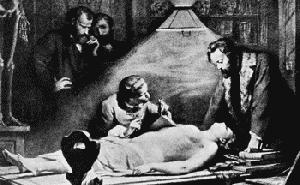Q: I am a writer trying to figure out what, if anything, a 19th century physician (actually the book is set in 1863) in a provincial Canadian backwater might conclude about a dead body found in salt water, which had a caved in skull and no water in the lungs. Would they indicate possible foul play? Would they even examine the lungs at autopsy?
A: In 1863, there was essentially no forensic science available. Fingerprints hadn’t been discovered to be a form of identification, blood typing was nearly a half century away, and DNA was a full century down the road. Ballistic examinations were not done. Toxicology was in its infancy as a method for uncovering arsenic in the tissues of a corpse had been developed by Jean Servais Stas, a Belgian chemist, in 1851. So, there wasn’t much forensic science around.
But, there was the autopsy. The examination of corpses and the determination if any diseases and injuries were present dates back many, many centuries. Ancient Egyptians performed something like autopsies but the first true autopsies to gain medical knowledge were likely performed by Erasistratus around 250 BC. Galen, the great first century Greek physician, was the physician to the gladiators and had extensive experience in anatomy and wounds. He wrote extensively on these and many other subjects and his shadow fell over medical knowledge well into the 19th century. Not always for the good, since he was wrong about almost everything. In 1350, autopsies were done on victims of the Black Death in the hopes of finding a cause for the pandemic. Over the next seven centuries the autopsy became more common and more sophisticated.

So, by 1863, the autopsy was well ingrained into the practice of medicine. This means that your physician could easily have the knowledge to perform them. Or not. Since he is in an isolated area, he could be out of the loop on that so you can have it either way. If he had any experience at all, he could determine whether the blow to the head was enough to kill the victim or not. He would see a skull fracture or bleeding into and around the brain. If he saw these, he might conclude that this was the cause of death. If he saw none of this, but merely a scalp bruise, he might conclude that drowning was the cause of death. He might not look at the lungs but simply know that the victim was found in water and assume that a drowning occurred. Or if he did examine the lungs and found them to be dry, he might say that drowning had nothing to do with it and the victim must have been dead at the time he entered the water. With dry lungs and no significant head injury he might not be able to say what caused the death. This gives you several options for how you construct your plot.
I should point out that dry lung drownings can occur and that any corpse—drowned or not—that has been in the water longer than 12 or so hours will have lungs filled with water. This is simply due to water seeping in and forcing the air out. Like a sponge dropped into water. But this was not known in 1863 so dry lungs might have suggested to your physician that no drowning occurred. He might be wrong but who could argue with his conclusion?
